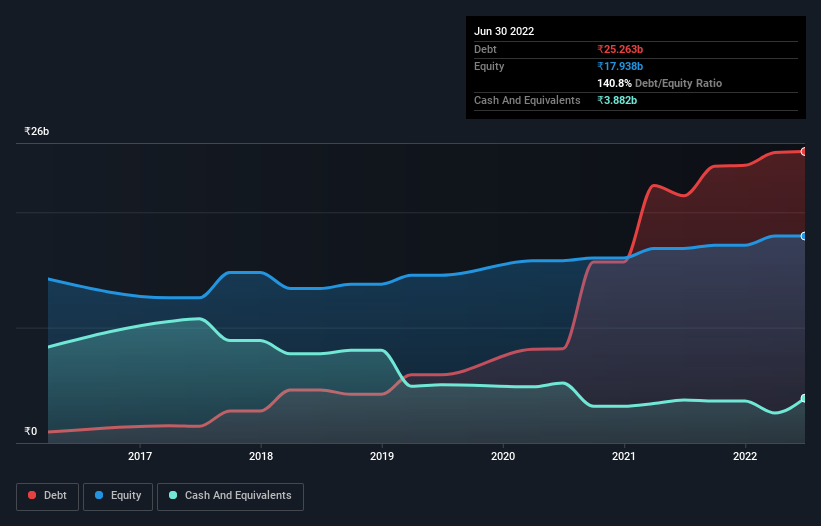- India
- /
- Construction
- /
- NSEI:WELENT
Welspun Enterprises (NSE:WELENT) Use Of Debt Could Be Considered Risky

Legendary fund manager Li Lu (who Charlie Munger backed) once said, 'The biggest investment risk is not the volatility of prices, but whether you will suffer a permanent loss of capital.' So it might be obvious that you need to consider debt, when you think about how risky any given stock is, because too much debt can sink a company. We can see that Welspun Enterprises Limited (NSE:WELENT) does use debt in its business. But should shareholders be worried about its use of debt?
What Risk Does Debt Bring?
Generally speaking, debt only becomes a real problem when a company can't easily pay it off, either by raising capital or with its own cash flow. If things get really bad, the lenders can take control of the business. While that is not too common, we often do see indebted companies permanently diluting shareholders because lenders force them to raise capital at a distressed price. By replacing dilution, though, debt can be an extremely good tool for businesses that need capital to invest in growth at high rates of return. The first step when considering a company's debt levels is to consider its cash and debt together.
View our latest analysis for Welspun Enterprises
How Much Debt Does Welspun Enterprises Carry?
As you can see below, at the end of March 2022, Welspun Enterprises had ₹25.3b of debt, up from ₹21.4b a year ago. Click the image for more detail. However, it also had ₹3.88b in cash, and so its net debt is ₹21.4b.

How Healthy Is Welspun Enterprises' Balance Sheet?
Zooming in on the latest balance sheet data, we can see that Welspun Enterprises had liabilities of ₹15.5b due within 12 months and liabilities of ₹25.5b due beyond that. On the other hand, it had cash of ₹3.88b and ₹6.51b worth of receivables due within a year. So its liabilities total ₹30.6b more than the combination of its cash and short-term receivables.
This deficit casts a shadow over the ₹18.5b company, like a colossus towering over mere mortals. So we definitely think shareholders need to watch this one closely. At the end of the day, Welspun Enterprises would probably need a major re-capitalization if its creditors were to demand repayment.
In order to size up a company's debt relative to its earnings, we calculate its net debt divided by its earnings before interest, tax, depreciation, and amortization (EBITDA) and its earnings before interest and tax (EBIT) divided by its interest expense (its interest cover). Thus we consider debt relative to earnings both with and without depreciation and amortization expenses.
Weak interest cover of 0.99 times and a disturbingly high net debt to EBITDA ratio of 12.1 hit our confidence in Welspun Enterprises like a one-two punch to the gut. This means we'd consider it to have a heavy debt load. More concerning, Welspun Enterprises saw its EBIT drop by 5.5% in the last twelve months. If that earnings trend continues the company will face an uphill battle to pay off its debt. The balance sheet is clearly the area to focus on when you are analysing debt. But you can't view debt in total isolation; since Welspun Enterprises will need earnings to service that debt. So when considering debt, it's definitely worth looking at the earnings trend. Click here for an interactive snapshot.
But our final consideration is also important, because a company cannot pay debt with paper profits; it needs cold hard cash. So we always check how much of that EBIT is translated into free cash flow. Over the last three years, Welspun Enterprises saw substantial negative free cash flow, in total. While that may be a result of expenditure for growth, it does make the debt far more risky.
Our View
To be frank both Welspun Enterprises's conversion of EBIT to free cash flow and its track record of staying on top of its total liabilities make us rather uncomfortable with its debt levels. And even its net debt to EBITDA fails to inspire much confidence. Considering all the factors previously mentioned, we think that Welspun Enterprises really is carrying too much debt. To us, that makes the stock rather risky, like walking through a dog park with your eyes closed. But some investors may feel differently. When analysing debt levels, the balance sheet is the obvious place to start. But ultimately, every company can contain risks that exist outside of the balance sheet. These risks can be hard to spot. Every company has them, and we've spotted 2 warning signs for Welspun Enterprises (of which 1 is significant!) you should know about.
Of course, if you're the type of investor who prefers buying stocks without the burden of debt, then don't hesitate to discover our exclusive list of net cash growth stocks, today.
Valuation is complex, but we're here to simplify it.
Discover if Welspun Enterprises might be undervalued or overvalued with our detailed analysis, featuring fair value estimates, potential risks, dividends, insider trades, and its financial condition.
Access Free AnalysisHave feedback on this article? Concerned about the content? Get in touch with us directly. Alternatively, email editorial-team (at) simplywallst.com.
This article by Simply Wall St is general in nature. We provide commentary based on historical data and analyst forecasts only using an unbiased methodology and our articles are not intended to be financial advice. It does not constitute a recommendation to buy or sell any stock, and does not take account of your objectives, or your financial situation. We aim to bring you long-term focused analysis driven by fundamental data. Note that our analysis may not factor in the latest price-sensitive company announcements or qualitative material. Simply Wall St has no position in any stocks mentioned.
About NSEI:WELENT
Welspun Enterprises
Engages in the engineering, procurement, and construction of infrastructure development projects in India.
Adequate balance sheet low.
Similar Companies
Market Insights
Community Narratives



